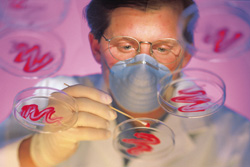Understanding cell wall regeneration in bacteria
The bacteria cell wall is the outermost layer encountered in some bacteria, algae and fungi, but is absent from animal cells. The absence of the cell wall renders L-form cells highly abnormal in size and shape, sensitive to osmotic shock but highly resistant to antibiotics that work on the cell wall. L-form cells at some stage revert to the walled state and disease resumes in patients with persistent or recurrent infections. It is, therefore, hypothesised that blocking regeneration may be a way of tackling these infections. However, our knowledge on the mechanisms that are implicated in this reversion is limited. The EU-funded 'Molecular biology of cell wall regeneration in L-form bacteria' (REGENERATE) project aimed to provide insight into the biology of L-form bacteria by focusing on their ability to revert to their cell walled state. Given the difficulty in generating and propagating L-forms, scientists used advanced genetic methods and mutant strains previously developed in the host lab. These tools enabled them to reproducibly obtain L-forms from laboratory strains of Bacillus subtilis. Proteoglycan (PG), the main constituent of the cell wall, is believed to require a primer for its synthesis and thus bacteria completely devoid of PG propagated for a period of time would be unable to regain their original shape. To test this hypothesis, REGENERATE scientists shut down PG synthesis in L-bacteria and propagated them for many generations. Then, by turning these genes on again, they observed that L-form cells could resume PG synthesis and revert to the cell walled state, thus disproving the priming theory. A better understanding of the cell wall regeneration process should provide important insight into the possible role of L-forms as causative agents of chronic infections. Through a delineation of the mechanisms implicated in the transition of L-bacteria to the walled state it will be possible to design novel anti-bacterial therapies to tackle such infections.



